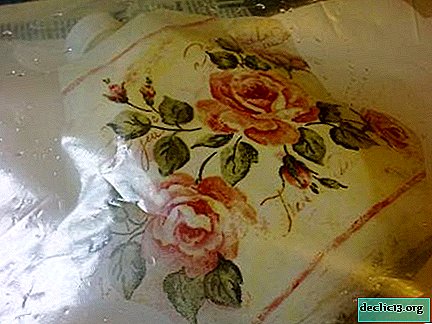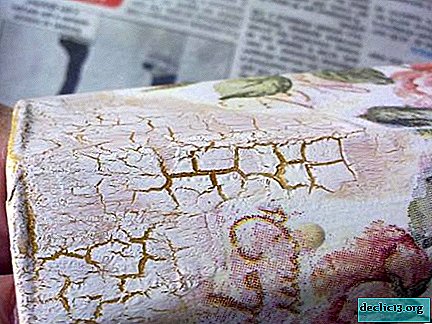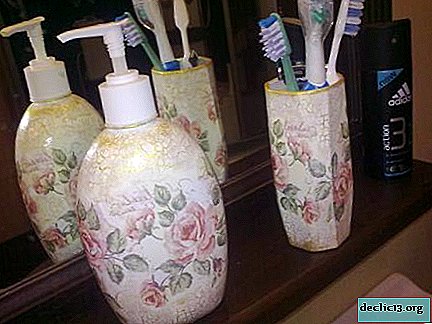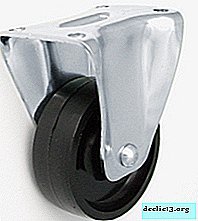Decoupage in the bathroom
Translated from French, decoupage means "cut", but this decor technique appeared in China, it was used to make furniture paintings. Today, decoupage is becoming increasingly popular, although this technique is practically a variant of collages. Decoupage is the gluing of cut-out drawings, ornaments from three-layer napkins to objects and any other surfaces that you would like to update or give them an exclusive look.
Bathroom update












The bathroom in the morning should instill vigor and major in us, and in the evening relax and give a comfortable feeling of relaxation. It is very important that the decor of the bathroom is not annoying and, if this happens, the tile is "to blame": the picture is tired or it's just old. And if repairs are not planned yet, then decoupage will be the best solution. In just a few hours, you can turn the bath into a work of art, a real paradise island in the apartment. Of particular interest are the floral arrangements in the form of panels.
Preparatory work for tile decoupage
First of all, you need to choose a decoupage motif. It should match or contrast with the color of the tile and fit compositionally. It is advisable to draw a sketch on paper. For decoration, three-layer napkins are suitable, which can be bought at a regular supermarket, usually there are 50 of them in a pack. You need decoupage glue and decoupage lacquer; they are sold in specialized stores and are expensive. An excellent replacement for these materials will be PVA glue and acrylic varnish, which are cheaper and can be found in any hardware store. In addition, you need sharp scissors, you can manicure, brushes and decoupage contour. At a cost it will be approximately 150 hryvnias (400-450 rubles).
Application technology
Cracks and Shabby Chic Retro Aging EffectFirst, prepare the surface: degrease with alcohol or a window cleaner and dry. Next, we cut out the pattern on a napkin and remove the lower two layers, it is easier to cut out until the napkin is divided. Then glue the picture. There are two options:
- You can apply glue to the tile, then stick it;
- and you can apply glue to the back of the picture.
Then we put glue on the front side and distribute it in a circular motion on the fragment surface. This is the most thorough part of the job, as the cloth becomes wet and may break. To prevent this from happening, you can sprinkle it with hair spray before work. After complete drying, apply acrylic varnish in two layers. If you want to give the picture a natural yellowness, use a varnish for yachts. Each layer must dry, otherwise the varnish will crack. Decoupage contour connect the pattern to the surface.
How to merge a napkin with a background?
Consider the detailed instructions on the example of a soap dish
Getting started
Here is what we need to get in the end!

Take a future accessory
We take a soap dish or any other dish

We clean and degrease
Remove all labels, degrease and clean with sandpaper for better grip. Next, we collect water in the container, this will protect it from bending.

Ground
It's time to primer. You can use building acrylic paint, as a more economical option, or art acrylic. It is necessary to apply two coats of soil.

We pass the skin
After the soil has dried, it is necessary to walk with a zero skin to obtain a smoother surface.

Glue a napkin
Next, cut out a piece of your favorite from a napkin. In our case, the napkin got very thin, so I had to glue it through a file. We lay on the file with the colorful side and using a fan brush, slowly pouring water, level the napkin.

Remove excess
Excess water can be drained, the napkin will not fall off, it holds tight.

We press
Now we attach the napkin to the necessary object and carefully press and remove the file.

Coat with glue
Now you need to dilute the PVA glue in water (1: 2) so that it glides and cover the product (you can use a fan brush or a finger, as you prefer).

Again we go sandpaper
Again, we clean the skin. Now with the help of acrylic gold paint we go through the places where we are going to make craquelure.

We apply craquelure composition
After the paint dries, we apply a craquelure one-component composition (in our case it is Decola) and wait at least 2 hours.

Create Cracks
Places with craquelure varnish are covered with acrylic paint. Cracks will appear immediately below the brush.

Finishing touches "
At the end of the edge can be gilded. We spray paint in several layers.

Done!
That's what we got

Appropriate place
This is how our accessory in the interior looks!

In this way, you can decorate the cabinets in the bathroom, shelves and even the "place of the thinker." Decoupage technique is just beginning to become fashionable, so you need to manage to make the interior in your apartment unusual in order to impress all your friends.
































